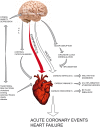Stress and Inflammation in Coronary Artery Disease: A Review Psychoneuroendocrineimmunology-Based
- PMID: 30237802
- PMCID: PMC6135895
- DOI: 10.3389/fimmu.2018.02031
Stress and Inflammation in Coronary Artery Disease: A Review Psychoneuroendocrineimmunology-Based
Abstract
Recent findings have deeply changed the current view of coronary heart disease, going beyond the simplistic model of atherosclerosis as a passive process involving cholesterol build-up in the subintimal space of the arteries until their final occlusion and/or thrombosis and instead focusing on the key roles of inflammation and the immune system in plaque formation and destabilization. Chronic inflammation is a typical hallmark of cardiac disease, worsening outcomes irrespective of serum cholesterol levels. Low-grade chronic inflammation correlates with higher incidence of several non-cardiac diseases, including depression, and chronic depression is now listed among the most important cardiovascular risk factors for poor prognosis among patients with myocardial infarction. In this review, we include recent evidence describing the immune and endocrine properties of the heart and their critical roles in acute ischaemic damage and in post-infarct myocardial remodeling. The importance of the central and autonomic regulation of cardiac functions, namely, the neuro-cardiac axis, is extensively explained, highlighting the roles of acute and chronic stress, circadian rhythms, emotions and the social environment in triggering acute cardiac events and worsening heart function and metabolism in chronic cardiovascular diseases. We have also included specific sections related to stress-induced myocardial ischaemia measurements and stress cardiomyopathy. The complex network of reciprocal interconnections between the heart and the main biological systems we have presented in this paper provides a new vision of cardiovascular science based on psychoneuroendocrineimmunology.
Keywords: atherosclerosis; coronary disease; cytokines; immune system; inflammation; psychoneuroendocrineimmunology; stress.
Figures



Similar articles
-
Research on psychoneuroimmunology: does stress influence immunity and cause coronary artery disease?Ann Acad Med Singap. 2010 Mar;39(3):191-6. Ann Acad Med Singap. 2010. PMID: 20372754 Review.
-
The integration of cardiovascular behavioral medicine and psychoneuroimmunology: new developments based on converging research fields.Brain Behav Immun. 2003 Aug;17(4):233-7. doi: 10.1016/s0889-1591(03)00051-5. Brain Behav Immun. 2003. PMID: 12831824 Review.
-
Emotional triggering of cardiac dysfunction: the present and future.Curr Cardiol Rep. 2015 Oct;17(10):91. doi: 10.1007/s11886-015-0635-3. Curr Cardiol Rep. 2015. PMID: 26298307 Review.
-
API expert consensus document on management of ischemic heart disease.J Assoc Physicians India. 2006 Jun;54:469-80. J Assoc Physicians India. 2006. PMID: 16909697 Review.
-
Heart-brain interactions in mental stress-induced myocardial ischemia.Curr Cardiol Rep. 2009 Mar;11(2):133-40. doi: 10.1007/s11886-009-0020-1. Curr Cardiol Rep. 2009. PMID: 19236829 Free PMC article. Review.
Cited by
-
Genus Amorphophallus: A Comprehensive Overview on Phytochemistry, Ethnomedicinal Uses, and Pharmacological Activities.Plants (Basel). 2023 Nov 23;12(23):3945. doi: 10.3390/plants12233945. Plants (Basel). 2023. PMID: 38068582 Free PMC article. Review.
-
Exploring the relation between Interleukin-6 and high-sensitive cardiac troponin T in asymptomatic hemodialysis patient: A cross-sectional study.PLoS One. 2024 Jan 25;19(1):e0296965. doi: 10.1371/journal.pone.0296965. eCollection 2024. PLoS One. 2024. PMID: 38271442 Free PMC article.
-
Objectively measured adherence to physical activity among patients with coronary artery disease: Comparison of the 2010 and 2020 World Health Organization guidelines and daily steps.Front Cardiovasc Med. 2022 Sep 28;9:951042. doi: 10.3389/fcvm.2022.951042. eCollection 2022. Front Cardiovasc Med. 2022. PMID: 36247452 Free PMC article.
-
Autophagy-mediated expression clusters are involved in immunity regulation of coronary artery disease.BMC Genom Data. 2022 Apr 2;23(1):24. doi: 10.1186/s12863-022-01023-3. BMC Genom Data. 2022. PMID: 35365066 Free PMC article.
-
Browning Epicardial Adipose Tissue: Friend or Foe?Cells. 2022 Mar 14;11(6):991. doi: 10.3390/cells11060991. Cells. 2022. PMID: 35326442 Free PMC article. Review.
References
Publication types
MeSH terms
LinkOut - more resources
Full Text Sources
Other Literature Sources
Medical

